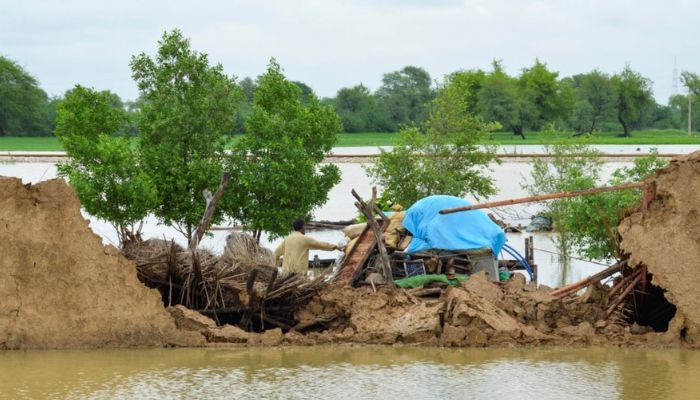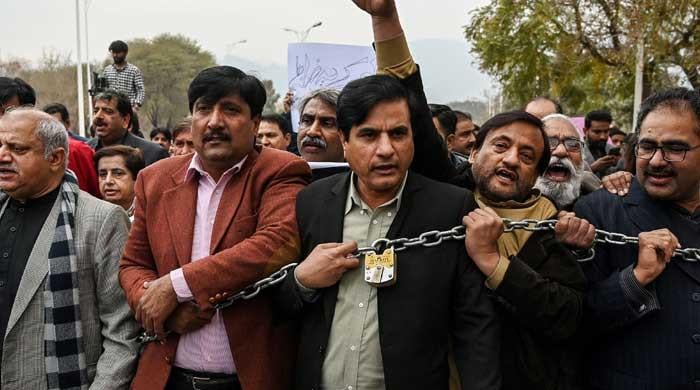Pakistan’s climate activists have been warning us since three decades
Pakistan needs to have zero self-consciousness or compunctions about demanding global climate justice for the people of the country, writes Mosharraf Zaidi
September 06, 2022

There are 33 million Pakistanis today whose lives have been directly affected by the 2022 floods. When the country experienced the 2010 floods, some of us thought we would never see anything like it again. This monsoon season is straight out of a horror film, but this is not original material. Like so much of what passes for culture these days, this is a remake.
In 2010, the total number of those affected by the floods was 20 million. The additional 13 million Pakistanis’ gap is not a small number – but a large share of this delta is not due to the scale or intensity of this year’s floods. It is due to the unmitigated and sustained population explosion that propels our nation’s size as being among the largest on the planet. No population projection has Pakistan below the fifth most populous nation on the planet. Depending on whether our Nigerian brothers and sisters decide to slow down, we may end up as high as third. There is no room for hubris, however; every new Pakistani is a future statistic.
What are the stats? Two in five Pakistanis can’t read. Among a crowd of a hundred homies, that’s 400,000. Among a hundred million? Its forty million Pakistanis for whom these words are squiggly lines. The under-five mortality rate in Pakistan is higher than most countries on the planet, at 65 children dying per 1,000 births. The number for Bangladesh is 29. Put another way, Bangladeshis are more than twice as good as keeping their babies alive as Pakistanis are. Pakistan is second from the bottom on the global gender gap index of the World Economic Forum – and it has stayed in that basement for what seems like forever.
Now, 33 million Pakistanis have been affected by the flood. When you do the big picture math, do it for those 33 million to get a sense of the kind of suffering extreme climate events are causing. Don’t worry; that suffering is coming to a vegetable stall, a petrol pump, and a voting booth near you, soon enough. Put on your Friday best, it is going to get ugly.
Pakistani climate activists have known this all along, and they are livid. The anger is fully justified. They have been warning us for three decades – quite literally since the 1992 summit in Rio de Janeiro – that bad days are ahead, unless some serious investment in sustainability is made. Not long after the Rio Summit, the population census of 1998 counted 132 million Pakistanis. This year, Pakistan's GDP is at around 234 million. That is a full 100 million new people since sustainability and climate have been proactively included in public policy.
"What? Included in public policy?!" you ask incredulously. Former president Asif Ali Zardari’s first ever job in government was solemnised on July 21, 1994 as the first ever chairperson of the Environment Protection Council, which was the institutional precursor to the Ministry of Environment and now the Ministry for Climate Change. The National Disaster Management Authority was created in 2010. But it had at least four predecessor organisations dating all the way back to the 1950s.
How people are cared for after a natural calamity makes a big difference. Pakistan has exhibited very little lesson learning from the 1971 experience—and there is one national institution that is especially immune to lesson learning. Balochistan’s people have been in a war zone since 2006. Young Baloch are sick and tired of running, hiding, and fearing. The state’s blunt and rigid instruments of engagement with the Baloch have now consistently been twinned with natural calamity upon natural calamity, nearly every year for over a decade. If anyone is making the mistake of thinking that a few Benazir Income Support Programme or Ehsaas Emergency Cash payments can heal the deep wounds in Balochistan, they should carefully revisit who they talk to, where those conversations take place, and what the incentives of their informants exactly are.
Of course, the BISP payments are a very basic and necessary instrument for how Pakistan will need to engage with flood victims. Combined with an inflationary wave that is unlikely to subside anytime before March 2023, over 150 million of the poorest citizens in Pakistan need a lot more than has ever been given to them.
Where will the money for this compassion and state-building come from? Pakistan has a total of $15.58 billion in external debt servicing payments due in the current fiscal year. Of this, nearly $3.5 billion is owed to multilateral institutions like the IMF, World Bank, and Asian Development Bank, and just over $3.6 billion is owed to commercial creditors (including the Chinese commercial banks that helped finance and build the power sector and road and highway infrastructure that fuel whatever Pakistani growth can be extracted from population growth, climate change, and conflict-afflicted system). The multilateral and commercial banks thus account for nearly half of the debt servicing payments owed by Pakistan. There can be no conversation of debt restructuring with these debtors, in part because of the consequences of such conversations on Pakistan’s creditworthiness.
There are two other kinds of external debt Pakistan will pay back this year. Bonds and bilateral creditors. Bonds are a separate category of external debt and represent both the present and future of how Pakistan will bridge finance its dollar-denominated needs. In short, holders of Pakistan-issued bonds need to be protected, from Pakistan, and Pakistan-risk, because one of the most important pathways of being a lower-risk country will be the country’s ability to issue more bonds on better terms.
This leaves Miftah Ismail and Prime Minister Shehbaz Sharif with a series of (more) trips to Beijing, Riyadh, Abu Dhabi and Doha. But this isn’t the full spectrum of their options. Pakistan owes the Paris Club countries (a group of 22 industrialized, advanced economies, including the US, France, Germany, the UK and Japan) a total of $1.175 billion this fiscal year on a debt stock of $10.7 billion.
The Paris Club countries are responsible for dramatically higher CO2 emissions, both historically and year on year, than their share. The government of Pakistan needs to concentrate its diplomatic, debt negotiation and economic affairs energies now on the conversion of the stock of debt owed to the Paris Club into swaps that help Pakistan deal with the immediate emergency caused by the 2022 floods today, and the various permanent emergencies that exacerbate the loss and damage caused by climate change.
As much as some of us are committed to fully owning (and fixing) Pakistan’s various and relentless dysfunctions, the extreme weather events that have defined 2022 so far are not products of Pakistani consumption nor Pakistani negligence. The impact of these events could certainly have been averted and minimised more capably; the country’s mitigation and adaptation measures leave much to be desired. But addressing the loss and damage caused by the heatwave that gripped the country in April, or the floods that have choked the lives and livelihoods of over 33 million Pakistanis is a responsibility that must be owned by the countries that have manufactured, consumed and partied this planet to the point of the kind of overheating (and drowning) manifest in Dadu, Qambar Shahdadkot, Kohistan, Swat, Jhal Magsi, Jaffarabad, and Dera Ghazi Khan.
Pakistanis, and especially the serious, down-to-business members of cabinet in this government that have taken so many hard decisions, need to have zero self-consciousness or compunctions about demanding global climate justice for the people of Pakistan. Demanding the right of the Pakistani people to be compensated for the destruction wrought on them due to global warming and extreme weather events is a foundational national duty for anyone that has a voice outside the country. Now is not the time to be shy about this.
The writer is an analyst and commentator.
Originally published in The News











